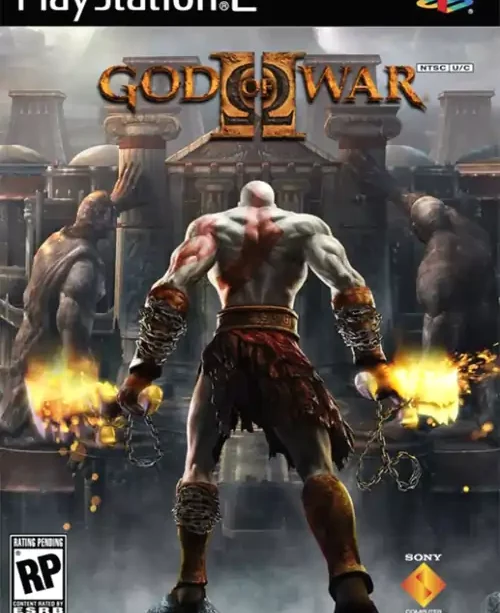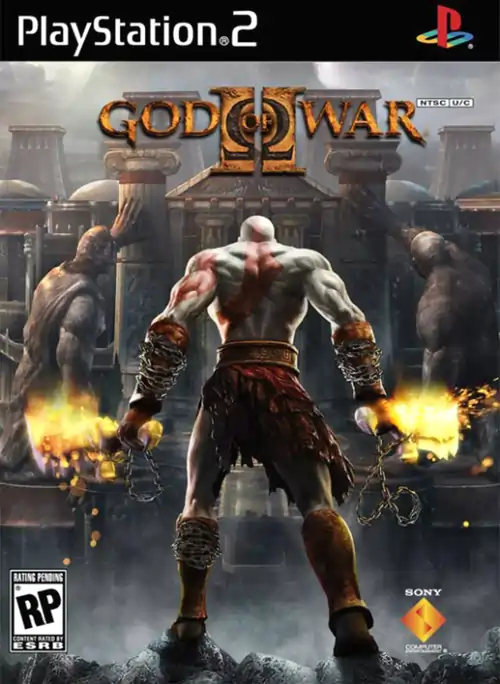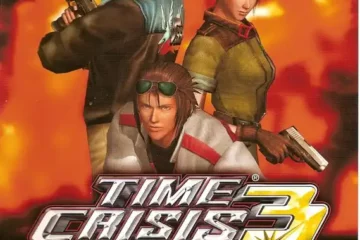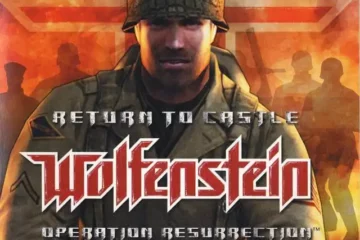
God of War II

Console: PS2
Publisher: Sony Computer Entertainment
Genre: Role-Playing
Region: Asia, AU, Australia, EU, JP, Korea, US
Released: March 13, 2007
File size: 6.65 GB
Continue Kratos’ epic journey through myth and vengeance in God of War II.
God of War II (2007): The PlayStation 2 Swan Song Masterpiece
Experience God of War II, PlayStation 2’s greatest finale. Complete guide to epic boss battles, new weapons, Sisters of Fate storyline, and ultimate collectibles.
Released March 13, 2007, God of War II emerged as PlayStation 2’s triumphant farewell, delivering an unprecedented epic that pushed the aging console beyond its technical limits while establishing new benchmarks for action-adventure gaming. When this game hit shelves four months after the PlayStation 3’s debut, some people scratched their heads and wondered why Santa Monica Studio was sticking with the older hardware. The answer became crystal clear the moment players booted up the game – this wasn’t just another sequel riding on the coattails of its predecessor.
The PlayStation 2’s Greatest Swan Song
Here’s the thing about swan songs – they’re supposed to be beautiful, memorable, and leave you wanting more. God of War II delivered on all three counts and then some. Under the direction of Cory Barlog, who took over from David Jaffe, this wasn’t just a simple sequel. It was the kind of game that made you realize the PlayStation 2 still had some serious fight left in it.
Barlog, who had been the lead animator on the original God of War, stepped into the director’s chair with what he later described as having “NO IDEA” what he was doing. But you know what they say about the best learning experiences – they happen under pressure. And boy, was there pressure. Taking over a franchise that had redefined action gaming wasn’t exactly a walk in the park, but Barlog and his team delivered something extraordinary.
Critical and Commercial Triumph
The numbers don’t lie when it comes to God of War II’s success. Critics weren’t just impressed – they were floored. The game earned a 93/100 on Metacritic, which in 2007 gaming terms was basically saying “this is as close to perfect as you’re going to get on PlayStation 2.” IGN went so far as to call it the second-best PlayStation 2 game of all time, which, considering the console’s incredible library, is saying something.
Awards and Recognition:
- PlayStation Game of the Year at the 2007 Golden Joystick Awards
- Complex Magazine’s “Best PlayStation 2 Game of All Time” (2012)
- GameSpot’s “Swan Song of the PlayStation 2 Era”
- 4.24 million copies sold by June 2012 (16th best-selling PS2 game ever)
Epic Storyline: Betrayal and Divine Retribution
God of War II picks up where its predecessor left off, but instead of giving Kratos a well-deserved break, it throws him into an even bigger mess. Our anti-hero has settled into his role as the new God of War, but there’s a problem – he’s still got that whole “insatiable bloodlust” thing going on. The other Olympian gods are getting nervous watching Kratos tear through Greek cities like a divine wrecking ball.
Then Zeus drops the ultimate betrayal. Think of it as the ancient Greek equivalent of being fired by your boss, except instead of losing your job, you lose your divine powers and get killed. Kratos, understandably, takes this about as well as you’d expect someone with severe anger management issues to take betrayal from the king of the gods.
The Sisters of Fate Mythology
Enter the Sisters of Fate – three primordial beings who make the Olympian gods look like amateur hour. These sisters don’t just influence destiny; they literally control it. We’re talking about the cosmic equivalent of having the universe’s source code at your fingertips.
The Three Sisters:
- Clotho – Weaves the threads of fate, basically deciding who gets born and when
- Lachesis – Measures thread length, determining how long you get to stick around
- Atropos – The one with the scissors, ending existence when your time is up
Their temple on the Island of Creation becomes Kratos’ ultimate destination – think of it as the cosmic customer service desk where he plans to file a very violent complaint about his recent treatment by Zeus.
The Titan Connection
One of the most brilliant aspects of God of War II’s story is how it weaves the ancient conflict between Titans and Olympians into Kratos’ personal vendetta. The Titans – those massive, primordial beings who ruled before Zeus and company took over – have been imprisoned for eons, nursing grudges the size of mountains. They see Kratos as their ticket to payback, and honestly, who better to lead a revenge mission than someone who’s already proven he can kill gods?
This mythological backdrop doesn’t just add depth to the story; it sets up what would become the epic foundation for God of War III’s climactic Titan War. Every interaction, every revelation builds toward something bigger than just Kratos’ personal quest for revenge.
Revolutionary Combat and Weapon Systems
If the original God of War established the combat formula, God of War II perfected it and then added some serious upgrades. We’re talking about a system that took everything players loved about the first game and dialed it up to eleven while smoothing out the rough edges.
Enhanced Blades of Athena
The Blades of Athena weren’t just renamed versions of the original weapons – they were divine upgrades with some serious improvements. These chained blades packed enhanced fire damage that actually looked impressive on screen, and the combo system supported over 25 different attack combinations. The developers weren’t kidding when they said you could string moves together in almost any order you wanted.
Combat Improvements:
- Divine Reckoning attack creates devastating tornado effects
- Extended chain length for better crowd control
- Enhanced visual effects that made every attack feel impactful
- Fluid combo system supporting 25+ attack combinations
Game-Changing Secondary Weapons
While the Blades of Athena were your bread and butter, God of War II introduced three secondary weapons that fundamentally changed how you approached different combat scenarios. Each weapon felt unique and served a specific purpose, rather than being cosmetic variations of the same thing.
The Barbarian Hammer was basically the sledgehammer approach to combat. Statistically, it was the most powerful melee weapon in the game (excluding the Blade of Olympus, but we’ll get to that monster later). This thing could summon spectral warriors to fight alongside you – imagine having your own personal ghostly army at your disposal.
The Spear of Destiny took a completely different approach. This wasn’t about raw power; it was about precision and range. Enhanced with purple crystals that gave it godly power, the spear was perfect for those moments when you needed to keep dangerous enemies at arm’s length while still dealing serious damage.
And then there was the Blade of Olympus – the ultimate “I win” button. This was the weapon capable of slaying Titans, which should give you an idea of its power level. You only got to use it at the beginning and end of the game (plus New Game Plus), and for good reason. In its upgraded form, every swing released energy blasts that could basically break the game’s balance if you had access to it throughout the entire adventure.
Expanded Magic Arsenal
The original game’s magic system was solid, but God of War II completely revamped the magical arsenal with four new abilities that each served distinct tactical purposes:
Magic Abilities:
- Cronos’ Rage – Electrical orbs that actively hunt down enemies
- Medusa’s Gaze – Enhanced petrification with area-of-effect damage
- Atlas Quake – Ground-pounding earthquake attacks for crowd control
- Rage of the Titans – Temporary invincibility with massive damage boost
Epic Boss Battles: Scale Beyond Imagination
If there’s one area where God of War II completely obliterated its predecessor, it was in the boss battle department. We went from a handful of memorable encounters to ten major boss fights that each felt like the climactic battle of their own game. This wasn’t just quantity over quality – every single encounter brought something unique to the table.
Colossus of Rhodes – Opening Spectacle
The game opens with what might be the most ambitious tutorial boss fight ever created. You’re facing off against a living bronze statue the size of a skyscraper, and the battle takes place both outside and inside the crumbling giant. What made this fight special wasn’t just its scale – it was how it showed cumulative damage in real-time. Every attack you landed visibly damaged the Colossus, creating this incredible sense of actually bringing down a massive opponent piece by piece.
This opening sequence set a new industry standard for cinematic presentation in games. It wasn’t just a boss fight; it was an interactive movie where you played the starring role.
Perseus – The Invisible Warrior
The Perseus encounter was pure tactical genius. Here was a boss that forced you to completely change your approach to combat. You couldn’t just button-mash your way to victory when your opponent was invisible most of the time. Instead, you had to learn to track his movements through footsteps, shadows, and environmental cues.
What made this fight even more special for longtime fans was the voice acting by Harry Hamlin, who played Perseus in the 1981 “Clash of the Titans” movie. It was the kind of casting choice that showed just how much attention the developers paid to Greek mythological authenticity.
The Sisters of Fate – Triple Boss Finale
The climactic encounter with the Sisters of Fate wasn’t just one boss fight – it was three interconnected battles that each required completely different strategies. Fighting Lahkesis and Atropos required tactical positioning and crowd management skills, while taking on Clotho felt more like battling a living building with environmental hazards at every turn.
Each sister’s unique mechanics reflected their mythological roles perfectly. It wasn’t just about making three different boss fights; it was about creating encounters that told the story through gameplay.
Zeus – The Ultimate Confrontation
The final battle against Zeus was where all of God of War II’s narrative threads came together. This wasn’t just another boss fight – it was Kratos literally rewriting his own fate. The battle took place at the moment of his original betrayal, with time manipulation mechanics that let you change the course of destiny itself.
The multi-phase combat showcased Zeus’s lightning powers while building toward an emotional conclusion involving Athena’s sacrifice. It was the kind of ending that left you immediately wanting to know what happened next, which is exactly what a great sequel should do.
Technical Marvel on PlayStation 2
Here’s what still amazes me about God of War II: it looked absolutely stunning on hardware that was already seven years old when the game launched. The PlayStation 2’s Emotion Engine and Graphics Synthesizer weren’t exactly cutting-edge by 2007 standards, but Santa Monica Studio squeezed every last drop of performance out of that aging silicon.
The game supported progressive scan (480p) output, which might not sound like much now, but back in 2007, it was the difference between a good-looking game and a great-looking one. Combined with proper 16:9 widescreen support and Dolby Pro Logic II audio, God of War II delivered a surprisingly modern multimedia experience on decidedly retro hardware.
Technical Achievements:
- Stable frame rates during massive boss battles and crowd scenes
- Seamless area transitions that eliminated loading screen interruptions
- Dynamic lighting systems that brought Greek mythology to life
- Enhanced particle effects for magic and environmental storytelling
Artistic Achievement
Critics consistently praised God of War II’s art direction over its pure technical specs, and for good reason. The game achieved something rare – a timeless aesthetic that avoided the “brown and bloom” trend that was dominating 2007 gaming. Instead, it captured mythological grandeur through environmental storytelling and character animations that surpassed many contemporary titles.
The cinematic presentation influenced an entire generation of games, establishing visual and narrative techniques that developers still use today.
Complete Collectibles and Secrets Guide
God of War II didn’t just expand the combat and story – it also significantly enhanced the collection system. This wasn’t your typical “find random power-ups scattered around” approach. Every collectible served a purpose and was placed with careful consideration for exploration and player progression.
Essential Collectibles
The core collectible system built on the original’s foundation but refined the presentation and distribution. Gorgon Eyes were still your ticket to increased maximum health, collected in sets of six for each upgrade. What changed was their placement – the developers got much more creative about hiding them in challenging or secret locations.
Phoenix Feathers worked the same way for magic meter expansion, also collected in sets of six. These blue collectibles often required significant platforming skills or puzzle-solving to reach, making each discovery feel genuinely rewarding.
Pro Collection Tips:
Urns of Power were the game’s secret weapons – special artifacts that provided game-modifying effects:
- Urn of Gaia: 10x red orb collection (makes upgrading much faster)
- Urn of the Gorgons: Infinite Rage of the Titans
- Urn of Olympus: 10x experience gain
- Urn of Prometheus: No magic consumption
Hidden Treasures
Gaia’s Gifts were the game’s equivalent of rare loot drops – three Überchests that contained substantial upgrades. These weren’t just lying around in plain sight; you had to earn them through exploration and skill. The Gift of Experience provided massive red orb bonuses, while the Gift of Health and Gift of Magic offered significant meter expansions.
Then there were the Cyclops Eyes – twenty of them, earned by defeating Berserker Cyclops enemies with finishing moves. This wasn’t about finding hidden chests; it was about demonstrating combat mastery. Collect all twenty, and you’d unlock a secret costume that was as much a badge of honor as it was a cosmetic reward.
Challenge of the Titans: Ultimate Test
If you thought completing the main story was challenging, the Challenge of the Titans mode was where God of War II separated the casual players from the dedicated ones. This wasn’t just a series of combat arenas – it was seven unique trials with bonus objectives that tested every skill you’d developed throughout the game.
Challenge Breakdown
The Seven Trials:
- Blind Fury – Defeat a Cyclops within strict time limits
- Death from Above – Kill 10 enemies while airborne
- Stone Shatter – Petrify and destroy 25 enemies
- Ring of Kronos – Protect the translator from enemy attacks
- Reap the Rewards – Collect 500 red orbs under pressure
- Survive – Defeat waves of enemies without dying
- Untouchable – Complete challenges without taking any damage
Ranking System and Rewards
The ranking system wasn’t just about bragging rights – it determined what content you could unlock. Mortal Rank was for basic completion, while achieving God Rank required perfect performance across all challenges with bonus objectives completed.
The rewards were worth the effort: Arena of the Fates for custom combat scenarios, exclusive Urns with game-breaking power-ups, seven unique costumes, and access to Titan Mode – a difficulty setting that made God Mode look like a warm-up.
Unlockable Content and Replay Value
God of War II was generous with its post-game content, offering substantial reasons to revisit the experience beyond just replaying the story. This was the kind of bonus material that actually enhanced the core experience rather than feeling tacked on.
Difficulty Modes
The five difficulty modes weren’t just damage multipliers – they offered genuinely different experiences. Scholar Mode was perfect for players who wanted to experience the story without getting stuck on combat challenges. Hero Mode provided the intended experience for most players, while Spartan and God Modes ramped up the challenge for experienced action game veterans.
Titan Mode, unlocked after completion, was reserved for players who wanted to prove something to themselves and the gaming community. This wasn’t just harder enemies; it was a complete recalibration of the game’s challenge curve.
Costume Collection
The seven unlockable costumes weren’t just cosmetic changes – many came with unique properties that altered gameplay. These ranged from completion rewards to difficulty-specific unlocks, with the Cyclops Eye costume requiring dedicated enemy hunting throughout the game.
Frequently Asked Questions
How long does God of War II take to complete?
Most players can expect 10-12 hours for the main story, with completionist runs extending to 15-20 hours when including all collectibles and challenges. The pacing is excellent – long enough to feel epic without overstaying its welcome.
What’s the best weapon for different situations?
The Blades of Athena are your go-to for general combat, the Barbarian Hammer excels against groups of enemies, the Spear of Destiny is perfect for precise attacks against tough opponents, and the Blade of Olympus (in New Game Plus) delivers maximum damage when you need it most.
Can I miss any collectibles permanently?
Most areas remain accessible throughout the game, but some Gorgon Eyes and Phoenix Feathers are tied to specific story moments. The good news is that the game is designed to be completion-friendly – you can return to most locations to collect missed items.
How does God of War II compare to the original?
God of War II improves upon its predecessor in virtually every measurable way – four times as many boss battles, refined combat mechanics, enhanced graphics, and superior pacing. It’s less a sequel than it is the definitive version of what the original game was trying to achieve.
Legacy: The Perfect PlayStation 2 Finale
God of War II stands as more than just an exceptional sequel – it represents the culmination of PlayStation 2’s technical and artistic potential. By choosing to remain on the older platform while the industry was rushing toward next-generation hardware, Santa Monica Studio created something truly special: a masterpiece that showcased what could be achieved when developers truly understood their hardware limitations and worked within them creatively.
The game’s influence extends far beyond its technical achievements. Its refined combat system became the template for countless action games that followed. The epic boss battles redefined what players expected from climactic encounters. The mature storytelling proved that games could handle complex mythological themes without talking down to their audience.
The Foundation for God of War III
The cliffhanger ending wasn’t just a sequel hook – it was a masterclass in narrative setup. By revealing the imprisoned Titans and establishing their motivation for assault on Mount Olympus, God of War II perfectly positioned the franchise for its PlayStation 3 debut. The exploration of the ancient conflict between Titans and Olympians provided the mythological foundation that would drive the trilogy’s conclusion.
Every story beat, every character interaction, every mythological reference was carefully crafted to build toward something larger than Kratos’ personal quest for revenge. It was world-building at its finest, creating a narrative foundation strong enough to support the epic conclusion that would follow.
Whether you experienced God of War II through the original PlayStation 2 version or discovered it through the enhanced God of War Collection, the game remains essential gaming. It demonstrates that true artistic vision can transcend technical limitations, creating experiences that feel timeless rather than dated. As PlayStation 2’s swan song, it proved that the best farewell is one that leaves audiences wanting more while celebrating everything that made the platform special.
God of War II didn’t just end the PlayStation 2 era – it ended it with style, substance, and the kind of epic grandeur that reminded everyone why they fell in love with gaming in the first place.
Related PlayStation Games:
Tom Clancy’s Splinter Cell – Chaos Theory
October 24, 2025Time Crisis 3
October 24, 2025Return to Castle Wolfenstein: Operation Resurrection
October 24, 2025



